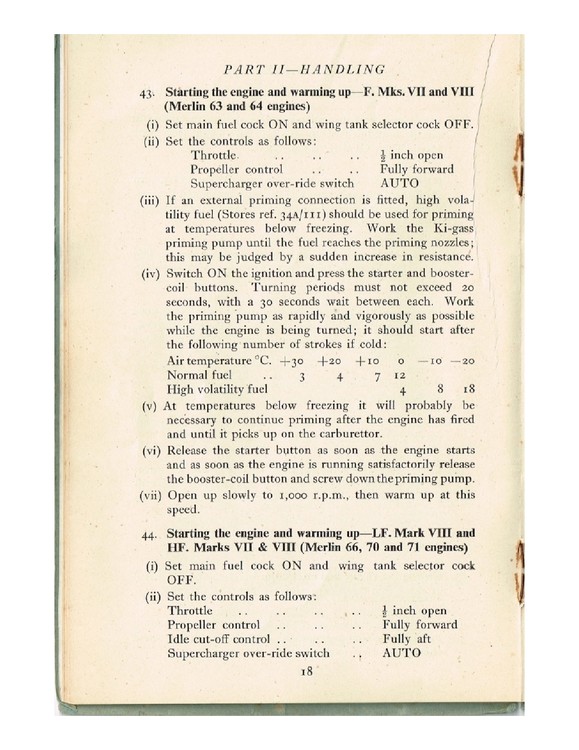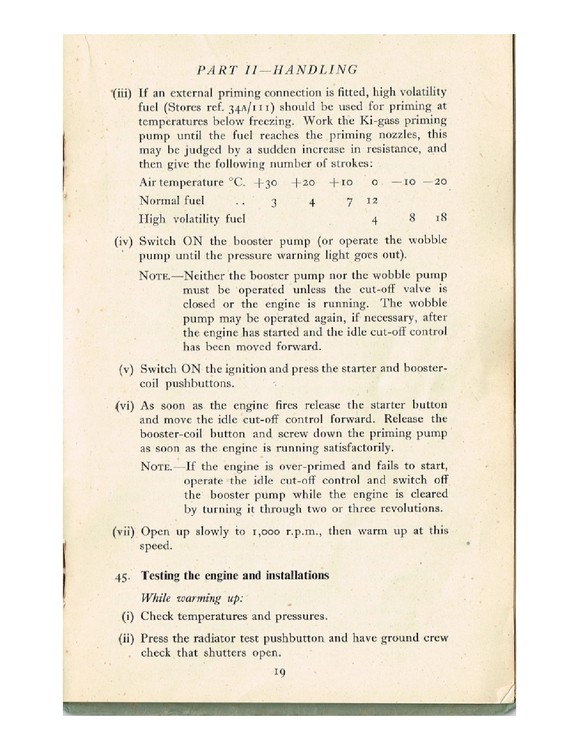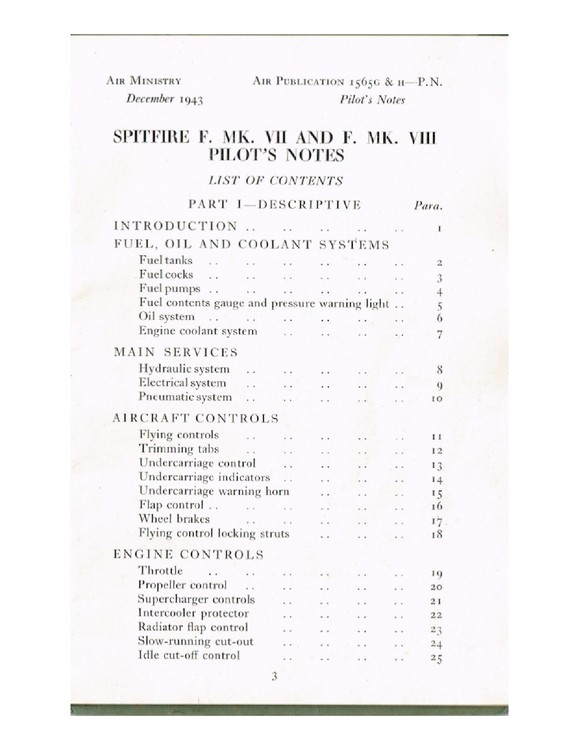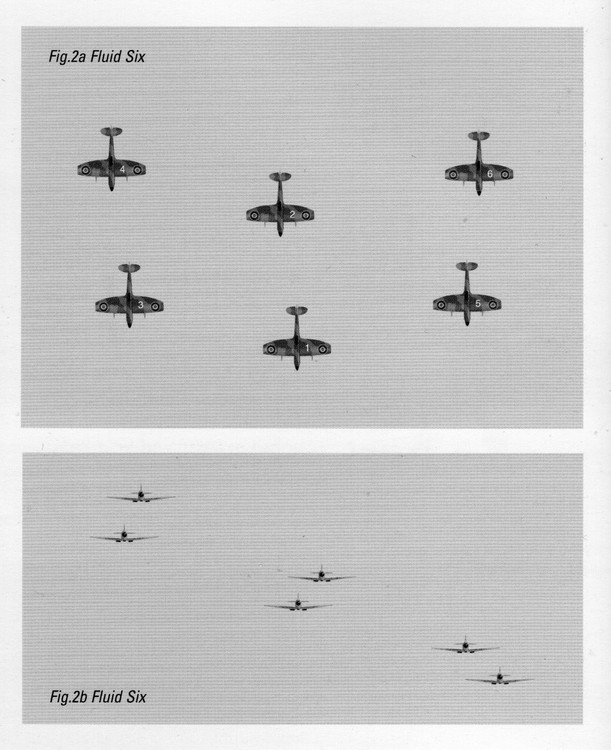-
Posts
709 -
Joined
-
Last visited
-
Days Won
1
Content Type
Profiles
Forums
Events
Everything posted by Friedrich-4B
-

Exhaust turn red al full power on Mk.IX?
Friedrich-4B replied to Silver_Dragon's topic in DCS: Spitfire L.F. Mk. IX
A couple of pages from the Merlin 60-70-80 series servicing manual: GENERAL NOTES states that The ground crew would light their cigarettes in the flames...:smoke: -

***DCS: AJS-37 Coming to DCS: World!***
Friedrich-4B replied to Cobra847's topic in DCS: AJS37 Viggen
YeeeeHaaaa! Me Likes... -
The startup sequence in the video matches the sequence in these Spitfire VII & VIII Pilot's Notes from 1943, with the small exception that the pilot release the starter button when the engine fires, push the idle cut-off control forward, then release the booster-coil button once the engine was running satisfactorily: I agree with Cateseye et al - it's no biggie. (mind you, I'd prefer a sequence where the pilot is asked to wind the elastic thingamajig 30 turns, crank the hoojah until it can't be cranked any more, open the whatsits 3 inches, pull the lever and prod the pedal... :pilotfly: )
-
Once you have weapons and an aircraft, you've gotta find ways to hit the target...
-
Starting with Luftwaffe weaponry: attached is a Luftwaffe Munitions handbook, and a 1945 document on rockets for Fw 190s. Handbuch_der_Bordwaffenmunition_1936_45.pdf
-
Ahh, okay that makes sense. (:doh: where is my Luftwaffe Ammunition for Dummies book when I need it?)
-
From what I can find, the main ingredient used in Luftwaffe tracer ammunition was phosphorus (phosphor), which would burn white or, sometimes, yellow: "Elektron" is also mentioned: AFAIK, this was a trade name for magnesium alloys, first developed in Germany: this seemed to be an incendiary, rather than a tracer:
-
Interesting; the throttle lever seems to have the twist grip that was used to adjust the recticle on a gyroscopic gunsight. From Here are some comments on adjusting the Merlin for long-range cruising.
-
The Merlin was a relatively complex engine (eg: about 11,000 parts, cf 7,100 for the Allison V-1710, not sure what the parts count for the DB605 was), mostly built using Rolls-Royce proprietary alloys and steels - like the cars, the quality of design and construction was high, but the trade off was extra weight. One reason the DB 601 & 605 series were light-weight is that they used magnesium for castings and other parts. As an interesting aside, this article describes how Merlins that are still in use in racing warbirds can be overhauled and modified to run at up to 150 inches of boost @ 3,800 rpm, generating 3,500 hp. From Alec Harvey Bailey: The Merlin in Perspective: The combat years:
-
Cut your losses and treat yourself to Eduard's beeeautiful IX's ; apart from Tamiya's 1/32 scale IXs, these are the best detailed, most accurate renditions available. They're also easy to build. (Eduard's latest 1/48 Bf 109G-5/6 and F-4's set the same standards) This is one of my Eduard IX's slightly modified to represent an F.R. Mk IXC of 16 Sqn, circa August 1944. Note that the beam approach aerial (the black, semi-circular fitting under the rear wing fairing) was fitted to many 2 TAF Spitfires: Back to the topic in hand; it can be hard being categorical about what details and modifications were applied to L.F. Mk IXs, without having photographic evidence. For example, MH727, built in September 1943, seemed to have had the Vokes Aero-vee fitted, either straight off the production line or soon after while at 39 MU: MH434, built in August 1943, didn't initially have the Vokes Aero-vee, but it did have the enlarged horn-balances. Another feature of many IXs was the disc "hub" fitted to the wheel - probably intended to keep mud and dust out. The only Spitfire IX's built with the original "type 1" elevators were conversions from Mk VC's and (possibly) some early, Supermarine built IXs in the ENxxx series. AFAIK, 1944 vintage, 2 TAF L.F. IXs all had the Aero-vee filter w/extended air intake and the larger horn balances. Apart from that, other detail differences could vary. For example, not all bomb-carrying IX's were fitted with the later 4-spoke wheels: this is PL265 (built circa 6-5-44) JH-V of 317(Polish) Squadron, early 1945: Another photo of 317 Sqn bomb-laden Spitfires, on a snowy, Grimbergen airfield in early 1945, shows ML293 JH-P had the 4 spoke wheels. Anyway, I'm not too hung up about the physical features of ED's L.F. Mk. IX for now, because such things can be modified. What's of far more importance is how she will fly.
-
Has anyone bothered reading Yo-Yo's original post?: Clearly Yo-Yo has accessed far more material than a few charts off the internet, for the Spitfire L.F. Mk. IX (and the Bf 190K-4), which is why DCS's IX should have performance figures that match production aircraft, rather than any one individual Spitfire. As it is, all of the other performance "issues", such as the K-4's ROC have been discussed, at length (ad nauseum in some cases), for the relevant FMs, so quite why they have to be re-litigated here is a little unclear.
-

TR 1143A Radio Manual (for Spitfire etc)
Friedrich-4B replied to Cripple's topic in DCS: Spitfire L.F. Mk. IX
Cheers Cripple, thanks for taking the trouble to post this.:thumbup: -
An "automated" set-up probably meant very little in the real world, because properly trained pilots would have had no problem controlling both throttle and propeller, even during combat. Once muscle memory is established, such things can be done automatically, without putting any conscious thought into the process. That's why helicopter pilots can fly helicopters and modern fighter pilots can use HOTAS to control so many different functions during combat.
-

DCS: Spitfire Mk LF IXc Discussion
Friedrich-4B replied to Yo-Yo's topic in DCS: Spitfire L.F. Mk. IX
A quick google shows MH434 has worn several paint/markings schemes; see forum thread MH434 and Her Many Guises, albeit there are no images of MH434 as AI-A. As it is, Fundekals have a good reputation for accuracy and quality etc, so you can be pretty sure that this set has been properly researched. -

PzKpfw-VI Ausf. E Tiger I Pics in Weekend Update
Friedrich-4B replied to Captain Orso's topic in DCS: WWII Assets Pack
Just for interest: From Jentz & Doyle , there were several names adopted officially throughout the Tiger I's design and production - for example, the designation was Pz.Kpfw.VI (VK 4501/H) Ausf.H1 (Tiger), from Feb 1942, and, from March 1943, became Panzerkampwagen Tiger Ausf E or Pz.Kpfw.Tiger (8.8cm L56) (Sd.Kfz.181). All referred to the same vehicle, and there was no differentiation between early, middle or late production Tiger Is. To narrow down ED's Tiger, it is an Ausf E with late, 7 periscope cupola and zimmerit (introduced July & August '43, respectively) and central headlight (introduced October '43), but it still has a shovel on the glacis, which was deleted c. Jan '44. Thus it was built sometime between October '43 and Jan '44. :smartass: Anyway, according to this post these are initial "first looks", so there's always going to be room for improvement. -

DCS: Spitfire Mk LF IXc Discussion
Friedrich-4B replied to Yo-Yo's topic in DCS: Spitfire L.F. Mk. IX
Of more interest to 1944 is that by 1943, 2 TAF Spitfire squadrons had adopted a formation known as the Fluid Six: (From Shores & Thomas - 2nd Tactical Air Force Volume Four:Squadrons, Camouflage and Markings, Weapons and Tactics 1943 - 1945.): -

DCS: Spitfire Mk LF IXc Discussion
Friedrich-4B replied to Yo-Yo's topic in DCS: Spitfire L.F. Mk. IX
Yep, I wondered about that. The film on rearming the Spitfire confirms that custom-made covers were used, although the principle's the same...sort of. :music_whistling: -

DCS: Spitfire Mk LF IXc Discussion
Friedrich-4B replied to Yo-Yo's topic in DCS: Spitfire L.F. Mk. IX
For the likes of the 20mm Hispano, a well known prophylactic product was used to seal the muzzle: -

DCS: Spitfire Mk LF IXc Discussion
Friedrich-4B replied to Yo-Yo's topic in DCS: Spitfire L.F. Mk. IX
Cheers, thanks for posting these. :thumbup: -

Was the Bf109K-4 a fighter-bomber?
Friedrich-4B replied to MiloMorai's topic in Military and Aviation
According to the JaPo book, the K series was originally designed to carry 30mm cannon in a standardised, aerodynamically refined airframe, while using the most powerful variants of the DB 605 that were either available or expected to be available. The K-4 was designed for the DB 605D series and came equipped as standard with the fuselage MW50/fuel tank, while many of its internal components were improved or re-positioned. When you think about it, the 109 was originally intended to be a light defense fighter armed with two rifle-calibre machine guns and powered by a c. 600 hp engine. That it was able to be continually updated and refined to be powered by an 1,800 - 1,975 hp engine, while being armed with an MK 108 and 2 MG 131s, plus all the other extra equipment, and still be a highly competitive fighter in 1945, shows just how well the basic airframe was designed in 1934. -

DCS: Spitfire Mk LF IXc Discussion
Friedrich-4B replied to Yo-Yo's topic in DCS: Spitfire L.F. Mk. IX
An excellent find, and thanks for sharing it. :thumbup: Attached are extracts from the August 1942 Spitfire IX Pilot's Notes (A.P 1565 J Merlin 61) giving the Spitfire IX's leading particulars (dimensions and areas). Also attached is a page from the same document that refutes claims, made by some self-proclaimed experts (based on a NACA document on the Spitfire VA) that the Spitfire IX was longitudinally unstable. -

DCS: Spitfire Mk LF IXc Discussion
Friedrich-4B replied to Yo-Yo's topic in DCS: Spitfire L.F. Mk. IX
Still. thanks for making them available. For interest, here are genuine WW2 Spitfire VII and VIII Pilot's Notes; many of the details are also relevant to the Spitfire L.F. Mk IX. Spitfire VII & VIII PN's a.pdf Spitfire VII & VIII PN's b.pdf Spitfire VII & VIII PN's c.pdf -

Soooo, you want a G-14 instead of the K-4?
Friedrich-4B replied to Kurfürst's topic in Western Europe 1944-1945
+1 There would be no point to developing a G-14 if, as claimed, its performance was not that dissimilar to the K-4, especially at the altitudes at which most combat missions are flown in ED. The only major difference would be in the armament of 1 x MG-151/20 and 2 x MG 131s. A G-6 would be better, because it was far more representative of the 109s in service for much of 1944. Anyway, there's already been heaps of discussion on what variants of the 109G or K could or should be modeled, so there's really no reason to raise it yet again in yet another thread. -

Guy Martin's Spitfire Documentary
Friedrich-4B replied to Charly_Owl's topic in DCS: Spitfire L.F. Mk. IX
'Tis indeed available on DVD https://www.amazon.co.uk/Guy-Martins-Spitfire-DVD-Martin/dp/B010B6BEL6 I didn't know that Guy Martin also featured on a program about the Avro Vulcan http://www.ebay.co.uk/bhp/guy-martin-dvd -
Fortunately, one can also justifiably criticize the critics for making accusations of bias, when the critics don't seem to understand the processes involved in finding and posting German combat reports etc. It takes dedication, lots of hard work and stacks of money - even so, there's no guarantee that such documents will actually be found and/or made available to the public.







